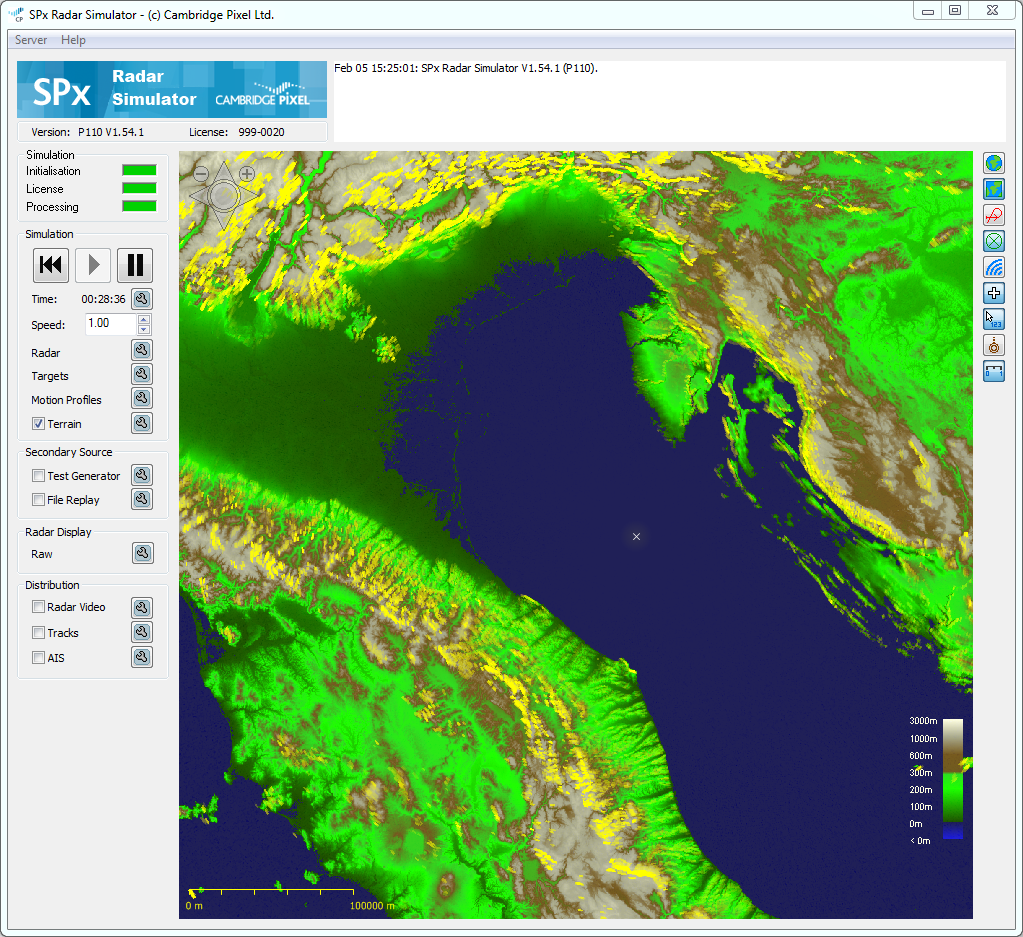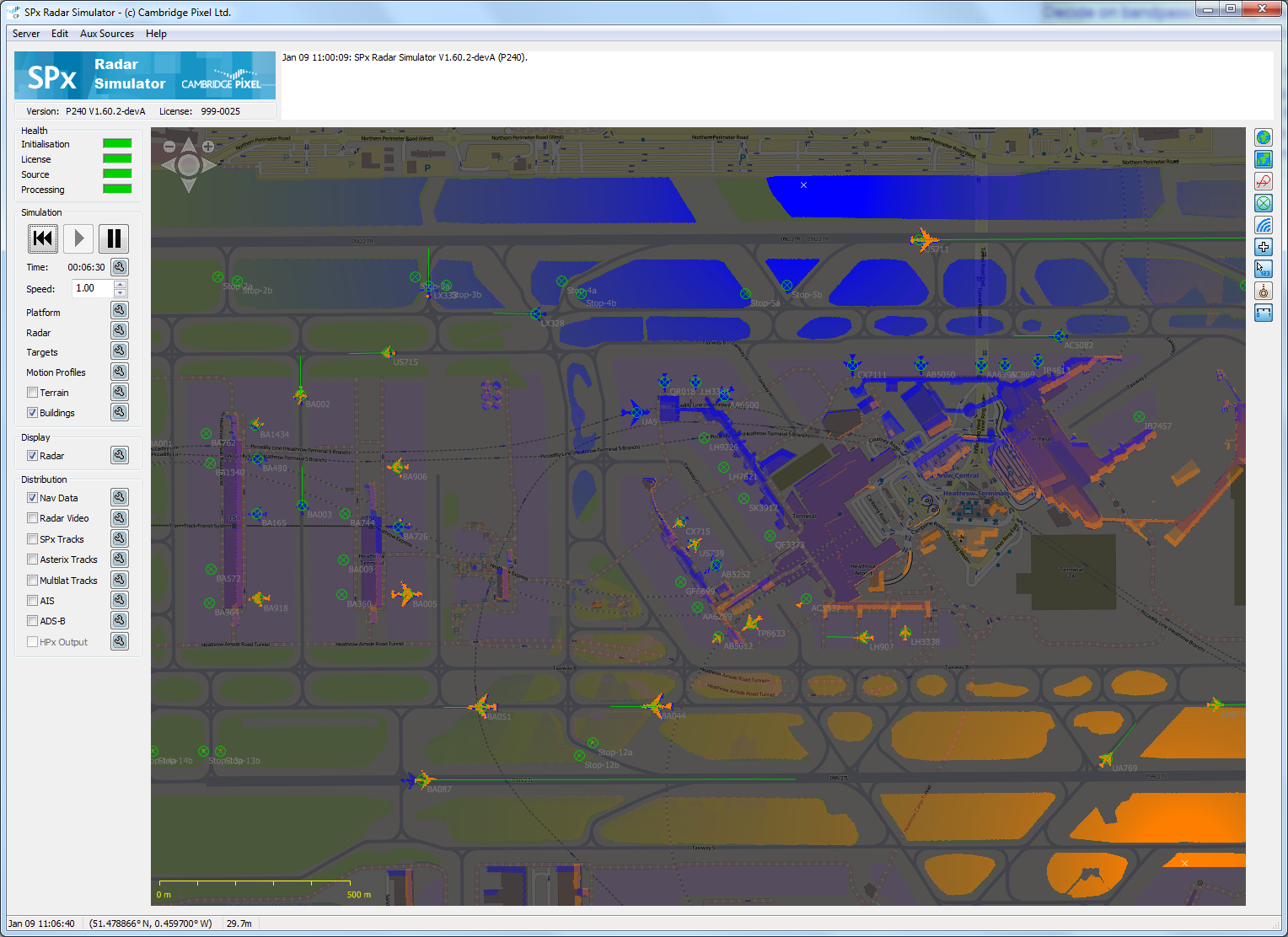SPx Radar Simulator provides intuitive graphical controls for its operation and for scenario creation, as well as a built-in radar display to show the simulated radar video and targets, on top of a map underlay. Targets may be defined at static locations or configured to follow user-defined motions (paths). The simulated radar origin may also be fixed at a static location or set to follow a user-defined motion. The Simulator provides graphical tools for the creation of targets and motions, allowing complex scenarios to be created and visualised with ease.
In addition to the synthetic radar video, navigation data and target data are available as separate outputs on the network. This allows SPx Radar Simulator to be used as a powerful test and development tool for real-world client radar display applications. Conversely, SPx Radar Simulator can also accept external data, for example from an existing simulation system, using this information to build the scenario and generating the corresponding radar video. Navigation data, target tracks, AIS and ADS-B feeds may all be input into SPx Radar Simulator. The application even allows you to augment a real radar video recording or network radar video input with additional, artificial targets.
SPx Radar Simulator is capable of generating highly realistic radar returns, from multiple radar sources, based on a set of terrain elevation data and user target definitions. The application uses altitude, beamwidth and pulse length considerations in its calculations, to create a convincing radar video image. Simulated sea clutter, as well as target RCS and radar sensitivity settings all contribute to the realistic dynamic appearance of the radar video.
The radar video generated by the Simulator may find use in a number of different applications. For example in testing radar display systems (ECDIS, Command & Control, VTS etc.), tracker configuration, operator training or even to demonstrate the possible radar clutter or expected radar coverage for a given location
The image on the left, below, shows radar video returns generated by SPx Radar Simulator for a specific geographic location. The image on the right shows real radar video from a Kelvin Hughes X-band SharpEye™ radar physically located at the same position. The simulator generates land clutter returns that offer a high degree of correlation with reality.
SPx Radar Simulator utilises terrain elevation data from NASA's "Shuttle Radar Topography Mission" (SRTM). This data set covers most of the world's landmass, with an accuracy of 3 arc-seconds in latitude and longitude.
The terrain data is used to calculate radar returns from land for a given platform position. The calculation of radar returns can optionally take into account the line-of-sight along each azimuth, so that land or targets that are obscured by terrain at shorter ranges are not displayed.

SPx Radar Simulator allows the user to define complex trajectories that targets or the radar platform itself may then be set to follow. These motions may be created and edited graphically, using the mouse in the display window. Alternatively, motions may be created by specifying their heading, speed and acceleration (linear or angular) directly within a configuration file.
Once defined, a motion may have several targets associated with it, separated in time or by a fixed offset. This can be useful for building up simulations where many targets follow a prescribed route (e.g. airport runways, vessel traffic channels, roads or railways).
SPx Radar Simulator supports multiple user-defined radar sources within a single simulation. Each radar source may be positioned at a different geographic location and a common set of target definitions used to create simulations of whole real-world installations. The view of the targets and the terrain from each radar is considered separately, so that it accurately reflects each radar's perspective on the scenario.
Typically, VTS, coastal surveillance and security applications may require installation of multiple radars along a stretch of coastline or around a perimeter or border. By supporting multiple radars, SPx Radar Simulator can provide application developers and system integrators working in these fields with a valuable realistic test source during the design and development phase.
As an alternative to defining targets by their length and breadth, they may be defined as complex polygons instead. This makes it possible for the user to create simulations of very high resolution radars (for example airport surface movement radars) which more accurately reflect the returns that may be expected from a real radar.
Similarly, buildings may also be defined by the user as complex polygons. Alternatively, Esri Shapefiles containing polygon definitions may be imported directly into the application and used to define buildings. As with targets and terrain, buildings contribute to the calculated radar video returns.
Like normal targets, shaped targets may be static or may be configured to follow a motion. In the case where a shaped target follows a motion, it is rotated as required to present the correct aspect to the radar.

For simulations where the platform is following a motion it is desirable to output the corresponding navigation data, describing the platform's instantaneous position and velocity. SPx Radar Simulator supports this and provides NMEA 0183 messages onto the network. A radar display client, such as Cambridge Pixel's RadarView, may then receive these messages along with the radar video data and render a moving platform display.
As well as artificial radar video data, target track messages may be generated and output for all user-defined targets . Target messages may be created and output in the form of primary radar tracks, AIS targets or ADS-B targets. Again, a display client may receive this data, along with the radar video, to render a complete display in the absence of live data.
SPx Radar Simulator fully supports Cambridge Pixel's HPx-300 Radar Signal Output card. The HPx-300 card takes the synthetic radar video data created by SPx Radar Simulator and uses it as the basis for generating radar signals (video, trigger and azimuth data). Together, SPx Radar Simulator and the HPx-300 card provide a complete, self-contained radar simulation package, capable of driving incumbant radar display equipment.
SPx Radar Simulator provides the user with full graphical control over all aspects of its operation. Controls are available to define the radar parameters, targets and motions, as well as to configure how the artificial radar video is generated.
A local PPI display window is also provided, which gives the user oversight of the radar video that the SPx Radar Simulator is generating. The PPI window also allows the user to define motion trajectories simply, using the mouse.
As well as the terrain display, tiled maps and world vector shoreline displays are available to add context to the radar video being displayed and to enable geographically realistic motion trajectories to be created.
All aspects of the simulation, including targets and motions, may be saved to and loaded from configuration files.
Target and motion data are stored in a separate file (or multiple separate files) to the main simulation configuration parameters. This provides a level of flexibility and makes it straightforward to share common scenarios across different simulations. For example, to simulate the same set of targets under different radar noise conditions or with the radar positioned in different locations.
Since the configuration files are ASCII text-based, they may also be edited or created externally of the SPx Radar Simulator.